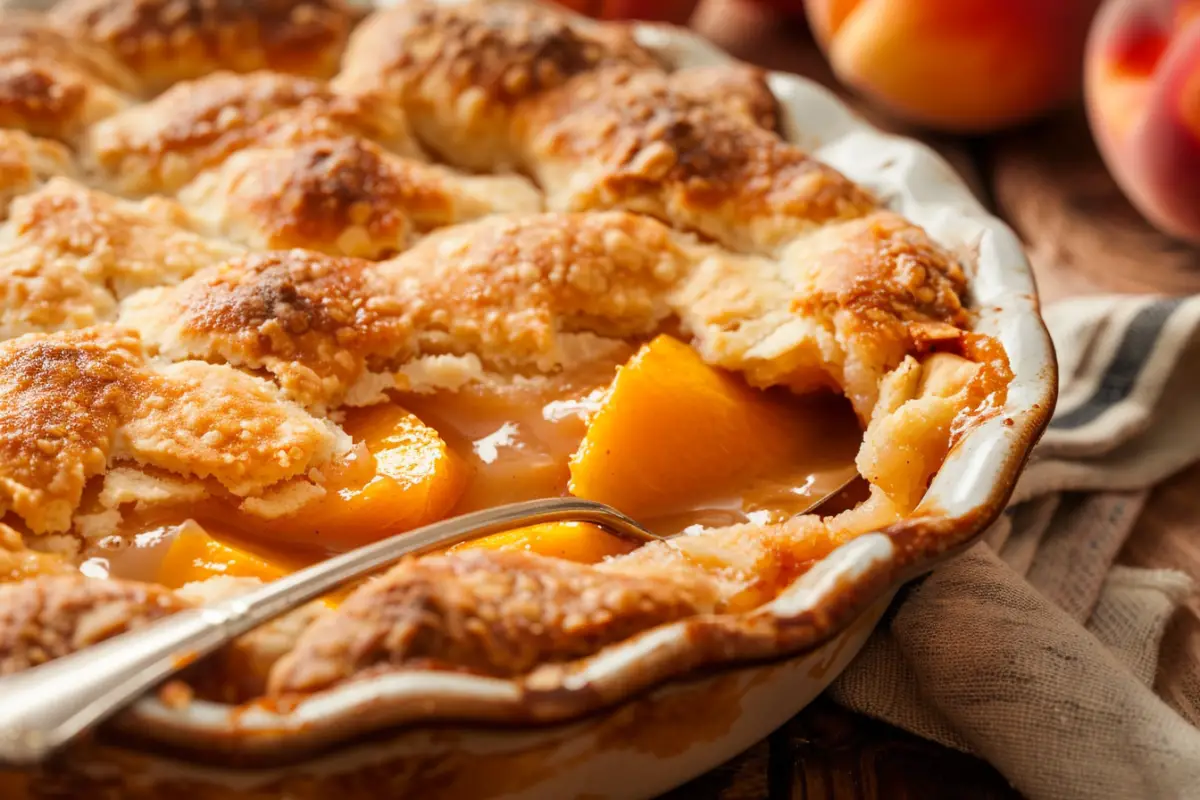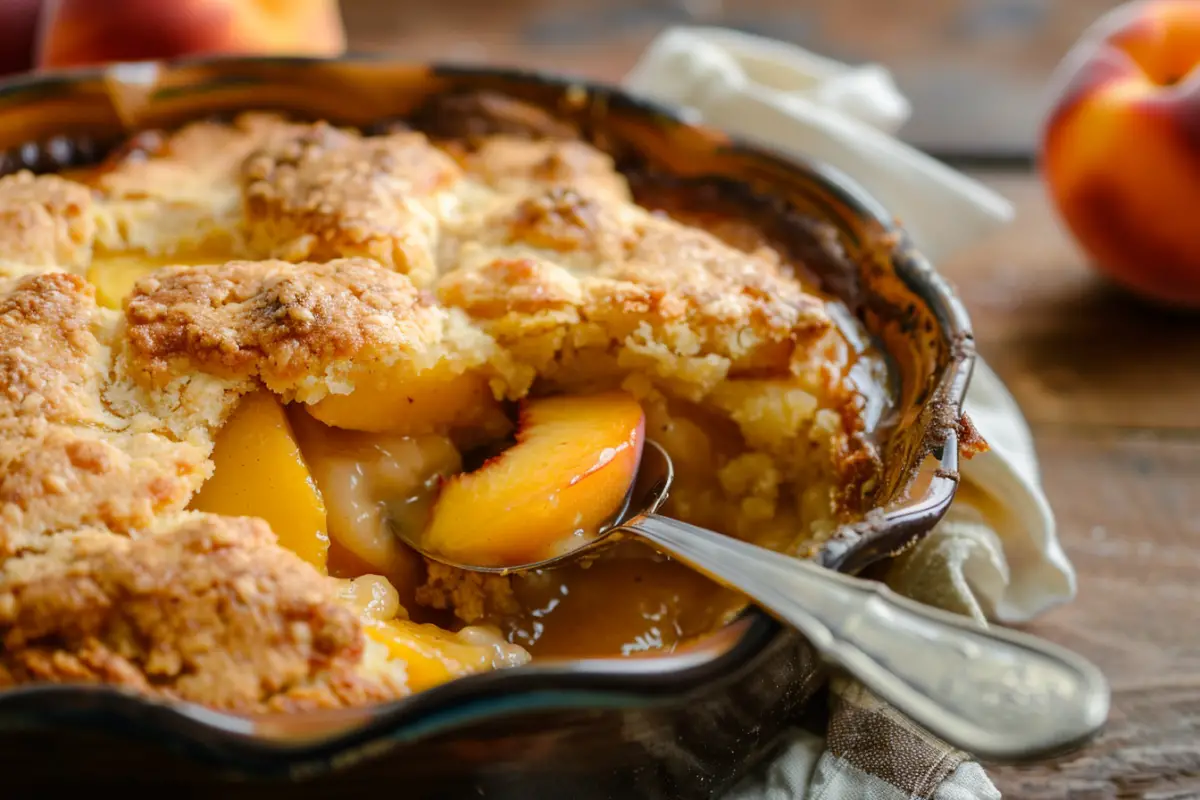Peach cobbler is a classic dessert that combines the sweetness of juicy peaches with a tender, crispy topping. While it’s a beloved treat, one of the most common issues home bakers face is a runny cobbler. Instead of that perfect balance of bubbling fruit and golden crust, the cobbler can sometimes end up soggy or overly juicy. So, how do you keep peach cobbler from being runny?
In this article, we’ll break down the reasons why peach cobbler can become runny, and more importantly, how to prevent it. Whether you’re using fresh, canned, or frozen peaches, we’ll explore the best techniques to ensure a perfectly textured dessert every time.
Why Peach Cobbler Becomes Runny
Understanding why your peach cobbler turned out runny is the first step to fixing the problem. Let’s look at the common reasons for this issue.
Natural Juices From the Peaches
Peaches are naturally juicy, and when they bake, they release even more liquid. Whether you’re using fresh, canned, or frozen peaches, the amount of juice they release during baking can affect the texture of your cobbler.
- Fresh Peaches: Fresh peaches can vary in their juiciness depending on ripeness. Overripe peaches will release more liquid during baking.
- Canned Peaches: Canned peaches are often packed in syrup, which adds extra moisture. If this isn’t drained properly, the cobbler can become too wet.
- Frozen Peaches: These tend to release more water when they thaw, making it essential to manage the extra moisture.
Improper Thickening of the Fruit Filling
One key reason for a runny peach cobbler is the lack of a proper thickener. Without it, the fruit juices don’t gel, leading to a soupy filling.
- Cornstarch: A common thickener for fruit pies and cobblers, cornstarch helps absorb excess liquid.
- Flour or Tapioca: These are alternatives to cornstarch that can also thicken the filling.
If you skip adding a thickener, the fruit juices will remain too liquid, leading to a runny cobbler.
Overly Juicy Peaches or Too Much Liquid
Sometimes the problem is simply that too much liquid was added to the recipe. Adding water, extra juice, or even too much sugar can cause the fruit to release more liquid during baking.
- Sugars: Sugar draws out moisture from the fruit, so using too much can exacerbate the problem.
The Importance of Using the Right Ingredients
Choosing the right ingredients is crucial in preventing your peach cobbler from being runny. Here’s how to select the best ingredients for success.
Choosing the Right Peaches
The type of peaches you use plays a big role in the consistency of your cobbler.
- Fresh Peaches: When in season, fresh peaches are a great option. They have less added moisture compared to canned or frozen varieties. However, make sure they are ripe but not overripe.
- Canned Peaches: If you’re using canned peaches, make sure to drain them thoroughly. Canned peaches are often packed in syrup or juice, which can add excess moisture.
- Frozen Peaches: If using frozen peaches, thaw them completely and drain any liquid that accumulates during thawing.
Balancing Sugar
While sugar enhances the flavor of the peaches, it can also cause them to release more liquid. If you find that your peach cobbler is consistently runny, try reducing the sugar content slightly.
- Less Sugar for Juicier Peaches: If your peaches are extra juicy, cut back on the sugar to prevent them from releasing too much liquid.
Adding Thickeners
A crucial step in keeping your peach cobbler from being runny is adding the right amount of thickener to the fruit filling.
- Cornstarch: One of the best thickeners for cobblers. Add 1–2 tablespoons of cornstarch to your peaches before baking.
- Flour or Tapioca: Both can be used in place of cornstarch. Flour adds a slightly more opaque appearance, while tapioca creates a clearer, gel-like texture.
Techniques to Prevent Peach Cobbler From Being Runny
There are several techniques you can use to ensure your peach cobbler has the right texture and consistency.

Draining Canned Peaches
If you’re using canned peaches, it’s essential to drain them properly before adding them to your cobbler. The syrup or juice from the can can add too much liquid to the dessert.
- How to Drain Canned Peaches: Place the peaches in a strainer and let the excess liquid drain for at least 5–10 minutes. You can also pat them dry with paper towels for extra precaution.
Pre-Cooking the Peach Filling
Pre-cooking the peach filling can help reduce excess moisture before the cobbler goes into the oven.
- How to Pre-Cook the Peaches:
- Heat the peaches in a saucepan over medium heat.
- Add sugar and any desired spices, like cinnamon or nutmeg.
- Stir in your thickener (cornstarch or flour) and cook until the mixture begins to thicken.
- Once the juices start to gel, remove from heat and let it cool before adding it to the baking dish.
Using the Right Thickener
The right thickener will help absorb the peach juices, preventing a runny filling.
- How to Measure and Add Thickeners: For every 4 cups of peaches, use about 1 to 2 tablespoons of cornstarch or 2 to 3 tablespoons of flour. Stir the thickener into the fruit mixture before baking to ensure it’s evenly distributed.
Proper Oven Temperature
Baking your cobbler at the right temperature is key to preventing a runny filling. A low temperature can cause the filling to remain liquid, while a higher temperature helps the thickener activate.
- Ideal Baking Temperature: Bake your cobbler at 350°F (175°C) to 375°F (190°C) for best results. This range allows the topping to crisp up while the fruit filling thickens.
Common Mistakes That Cause a Runny Cobbler
Even experienced bakers can make mistakes that lead to a runny cobbler. Here are the most common pitfalls and how to avoid them.
Adding Too Much Liquid
One of the biggest mistakes is adding too much liquid to the cobbler filling. This could be from the syrup of canned peaches, extra water, or even too much juice from fresh peaches.
- Avoiding Excess Liquid: If the peaches seem too juicy, consider reducing the amount of sugar or avoid adding extra liquid.
Skipping the Thickener
Skipping the thickener is another common mistake. While some cobbler recipes don’t call for one, adding a thickener like cornstarch or flour ensures that the filling will set properly.
Incorrect Baking Time
Baking the cobbler for too short a time can also lead to a runny filling.
- Baking Long Enough: The cobbler should bake until the topping is golden and the fruit is bubbling around the edges, usually 40-45 minutes. If the fruit isn’t bubbling, it means the filling hasn’t thickened enough.
How to Fix a Runny Peach Cobbler After Baking
If your cobbler is already baked and turns out runny, don’t worry—there are a few ways to salvage it.
Broiling the Topping
If the filling is too wet but the topping looks good, try broiling the cobbler for a couple of minutes. This can help the topping crisp up while the juices thicken underneath.
- How to Broil: Place the cobbler under the broiler for 2-3 minutes, keeping a close eye on it to prevent burning.
Letting the Cobbler Rest
Letting the cobbler cool for at least 30 minutes before serving can help the juices thicken naturally.
- Why Resting Helps: As the cobbler cools, the fruit juices will set, making it easier to serve without the filling being too runny.
Rebaking the Cobbler
If the cobbler is still too runny, you can place it back in the oven to bake longer.
- Rebake at a Lower Temperature: Try baking it at 325°F (160°C) for an additional 10-15 minutes to give the filling more time to set.
Adding Thickening Agents Post-Baking
If the cobbler is still too liquid after baking, you can add a cornstarch slurry to thicken it.
- Cornstarch Slurry: Mix 1 tablespoon of cornstarch with 1 tablespoon of water, then stir it into the cobbler filling. Bake for an additional 10-15 minutes.
Variations of Peach Cobbler and How They Affect the Texture
The type of cobbler you make can also impact how likely it is to turn out runny.
Classic Southern Peach Cobbler
Southern-style cobblers typically have a biscuit topping, which can absorb some of the fruit juices. However, if the filling is too wet, even this type of cobbler can become runny.
Peach Cobbler with Biscuit Topping
A biscuit topping is thicker and denser than cake batter, which helps prevent a runny texture. However, the biscuit topping can sometimes become soggy if the fruit juices aren’t thickened enough.
Peach Cobbler with Cake-Like Topping
Cake-topped cobblers are more likely to become runny if too much liquid is added to the filling. The light, fluffy cake absorbs the juices, which can turn the topping mushy if the filling isn’t properly thickened.
How to Choose the Right Recipe to Prevent a Runny Peach Cobbler
Understanding Recipe Variations
Not all cobbler recipes are the same. Some will call for more liquid in the filling, while others may skip the thickener altogether. Choose a recipe that specifically addresses the issue of thickening the filling.
Reading Reviews and Comments
Before trying a new recipe, check the reviews. If multiple users mention that the cobbler turned out runny, consider modifying the recipe by adding a thickener or adjusting the sugar content.
Adjusting Recipes to Your Preferences
If you know you’re working with particularly juicy peaches, adjust the recipe to account for that. Use more thickener, reduce the sugar, or pre-cook the fruit to remove some excess liquid.
Serving Suggestions and Final Thoughts on Preventing a Runny Cobbler
Once you’ve perfected your cobbler’s texture, it’s time to serve it up!
Perfect Pairings for Peach Cobbler
- Vanilla Ice Cream: A classic pairing that adds cool creaminess to the warm cobbler.
- Whipped Cream: Light and fluffy, whipped cream is a great way to top off a cobbler.
- Custard: For a richer dessert, serve the cobbler with a drizzle of custard.
Recap of Key Tips
To keep your peach cobbler from being runny:
- Drain canned or thawed frozen peaches.
- Use the right thickener, like cornstarch or flour.
- Bake at the correct temperature and for the proper amount of time.
- Let the cobbler rest before serving to allow the juices to set.
FAQs
What’s the difference between a peach cobbler and a crumble?
A peach cobbler has a biscuit or cake-like topping, while a crumble has a streusel-like topping made of flour, butter, and sugar.
Why did my cobbler turn out like cake?
Your cobbler may have turned out like cake if the batter was too thin or overmixed. Using the wrong topping recipe can also result in a cake-like texture.
Why is my peach cobbler crust soggy?
A soggy crust can occur if the filling is too liquid or if the cobbler wasn’t baked long enough to allow the topping to crisp up.
Conclusion
In conclusion, keeping your peach cobbler from being runny is all about managing the moisture content of the fruit, using the right thickener, and ensuring the baking process is just right. By following these tips, you’ll be able to create a delicious, perfectly textured cobbler that will impress every time. So, go ahead, give it another try, and enjoy a warm, juicy cobbler that’s anything but runny!

